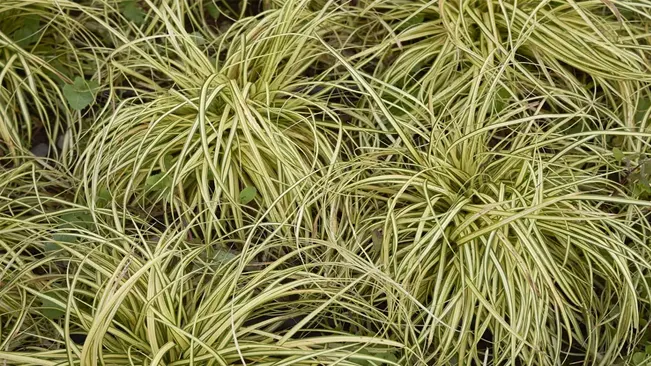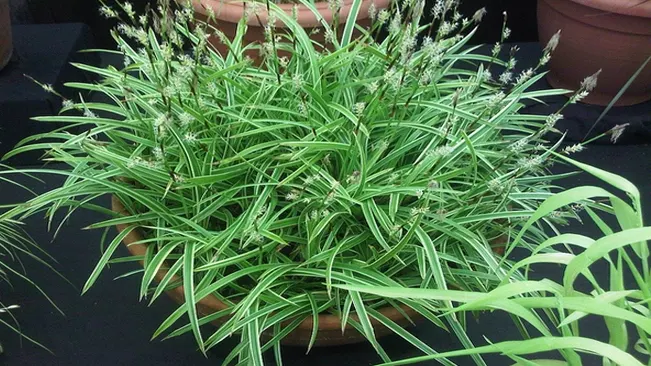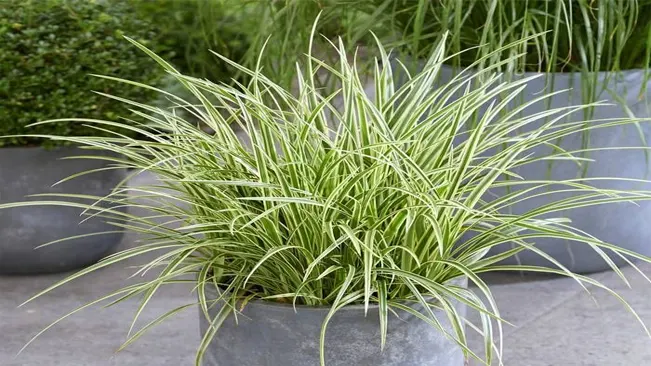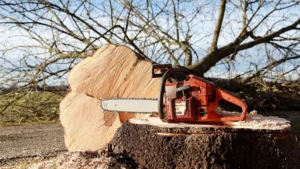How to Grow Japanese Sedge: Comprehensive Guide for Lush Growth
- March 7, 2024
- 0 comment
Japanese Sedge, scientifically known as Carex morrowii, is a perennial grass-like plant native to Japan. It is highly valued in gardening and landscaping for its attractive foliage and easy maintenance. This article provides a comprehensive guide on how to successfully grow and care for Japanese Sedge in your garden.

How To Grow Japanese Sedge
- Choosing the Right Variety
- Planting Japanese Sedge
- Watering and Feeding
- Pruning and Maintenance
- Pest and Disease Management
- Landscaping with Japanese Sedge
Choosing the Right Variety
There are several varieties of Japanese Sedge, each with unique characteristics. Some popular varieties include ‘Ice Dance’, ‘Variegata’, and ‘Gold Band’. Select a variety that complements your garden’s aesthetic and climate conditions.
Ice Dance (Carex morrowii ‘Ice Dance’)

- Appearance: ‘Ice Dance’ is known for its striking variegated leaves. The foliage is dark green with bright, creamy-white edges, creating a contrasting and eye-catching appearance.
- Growth Habit: This variety tends to form dense, slowly spreading clumps, making it an excellent choice for ground cover or border planting.
- Size: It typically grows to about 12-18 inches in height and spread.
- Sunlight and Soil: ‘Ice Dance’ is adaptable to a range of light conditions, from full shade to partial sun, and prefers moist, well-drained soils.
Variegata (Carex morrowii ‘Variegata’)

- Appearance: The ‘Variegata’ variety is noted for its elegant, narrow leaves with white margins. The variegation in this variety is more pronounced and consistent.
- Growth Habit: It forms neat, compact mounds that are suitable for smaller spaces or as accent plants.
- Size: It generally reaches about 10-15 inches in height and width.
- Sunlight and Soil: Prefers partial shade but can tolerate more sun than other varieties, provided it gets enough moisture. It thrives in rich, well-draining soil.
Gold Band (Carex morrowii ‘Gold Band’)

- Appearance: ‘Gold Band’ features broad leaves with bright golden-yellow edges. The vibrant color adds a splash of brightness, especially in shaded areas.
- Growth Habit: This variety forms tidy, upright clumps and is less aggressive in spreading compared to some other varieties.
- Size: It grows to about 15-20 inches tall and wide.
- Sunlight and Soil: It does best in partial shade to shade and prefers consistently moist soil.
Planting Japanese Sedge
Timing
- Early Spring Planting: Planting in early spring allows Japanese Sedge to establish its root system before the heat of the summer. This timing is ideal as the soil is beginning to warm up, which promotes root growth.
- Fall Planting: Planting in the fall takes advantage of the cooler temperatures and usually more consistent moisture levels. The plant will have time to establish before winter, preparing it for spring growth.
Soil Requirements
- Well-Drained, Moist Soil: Japanese Sedge prefers soil that retains moisture but also allows excess water to drain away. Poor drainage can lead to root rot.
- Soil pH and Nutrients: This plant is not overly fussy about soil pH, thriving in slightly acidic to neutral soils. It’s beneficial to incorporate organic matter into the soil before planting to enhance nutrient content and improve soil structure.
- Tolerance to Various Soil Types: Its adaptability to different soil types, including clay, loamy, and sandy soils, makes it a versatile choice for many garden settings.
Sunlight
- Partial to Full Shade: Japanese Sedge does best in partial shade where it receives some sunlight but is protected during the hottest part of the day. This makes it ideal for planting under trees or in the shadow of buildings.
- Avoid Intense Sun: In regions with very hot summers, intense afternoon sun can scorch the leaves. In such areas, ensure the plant gets shade during the peak hours.
Spacing
- 12 to 18 Inches Apart: Spacing is important for several reasons:
- Growth: Japanese Sedge can spread over time. Proper spacing allows each plant enough room to grow without overcrowding.
- Air Circulation: Adequate space between plants promotes better air circulation, reducing the risk of fungal diseases.
- Aesthetic Appeal: Spacing them out can create a more organized and visually appealing garden bed.
Watering and Feeding
Watering Japanese Sedge
- Consistent Moisture is Key: Japanese Sedge prefers soil that is consistently moist. This doesn’t mean the soil should be overly soggy or waterlogged, as this can lead to root rot. The goal is to maintain a balance where the soil is neither too dry nor too wet.
- Deep Watering Method: Instead of frequent shallow watering, opt for deep watering. This means watering in a way that the moisture reaches deeper into the soil. This encourages the roots to grow deeper, which in turn makes the plant more drought-tolerant and robust.
- Monitoring Soil Moisture: During hot and dry periods, check the soil more frequently. The top inch of the soil should not be allowed to dry out completely. In cooler or cloudy weather, reduce the frequency of watering as the soil will retain moisture for longer.
- Watering in Different Seasons: In spring and summer, you might need to water the plants more frequently due to higher temperatures and evaporation rates. In fall and winter, reduce the watering as the plant’s growth slows down, and the soil retains moisture longer.
Fertilizing Japanese Sedge
- Choosing the Right Fertilizer: A balanced, slow-release fertilizer is ideal for Japanese Sedge. Balanced fertilizers have equal parts of the primary nutrients (nitrogen, phosphorus, potassium), often indicated by a ratio like 10-10-10.
- Timing of Application: The best time to fertilize is in spring when the plant is entering its active growth phase. This provides the sedge with necessary nutrients to support new growth.
- Method of Application: Follow the instructions on the fertilizer packaging for application. Generally, the fertilizer is spread evenly around the plant, avoiding direct contact with the foliage and roots.
- Avoiding Over-fertilization: Over-fertilizing can lead to lush, weak growth that may flop or lose its attractive form. It can also increase the susceptibility of the plant to pests and diseases. Stick to the recommended amount and frequency.
- Signs of Over-fertilization: Watch for signs like yellowing leaves, stunted growth, or a crust of fertilizer on the soil surface. If you suspect over-fertilization, water thoroughly to help flush out excess fertilizer.
- Organic Options: If you prefer organic gardening, consider using compost or well-rotted manure in place of synthetic fertilizers. These not only provide nutrients but also improve soil structure and health.
Pruning and Maintenance
Pruning
- Timing: The best time to prune Japanese Sedge is in late winter or early spring. This timing is crucial as it prepares the plant for new growth that typically begins in the spring.
- Technique: When pruning, you should aim to remove old, brown, or damaged foliage. This not only enhances the plant’s appearance but also encourages healthier, more vibrant growth.
- Tools: Use sharp, clean shears or scissors for pruning. This ensures clean cuts and reduces the risk of disease.
- Extent: Avoid cutting the plant back too severely. Generally, it’s advisable to remove about one-third of the plant’s height. This will keep it looking full and lush while promoting new growth.
Mulching
- Purpose: Mulching serves several purposes. It helps retain soil moisture, which is essential for the health of Japanese Sedge. It also suppresses weed growth, which can compete with your sedge for nutrients and water.
- Material: Organic mulch, such as shredded bark, leaf mold, or compost, is recommended. These materials not only serve the practical purpose of mulching but also gradually break down and enrich the soil.
- Application: Apply a layer of mulch around the base of the plant. Be careful not to pile mulch directly against the stems, as this can lead to rot.
Dividing
- Why Divide: Over time, Japanese Sedge can become overcrowded, which may impede its growth and lead to poor appearance. Dividing the plants helps to rejuvenate them and encourage more vigorous growth.
- When to Divide: The best time to divide Japanese Sedge is in the spring, just as new growth begins. This allows the plant to recover quickly and take advantage of the growing season.
- How to Divide:
- Dig Up: Carefully dig around the plant and lift it from the ground, trying to keep the root ball intact.
- Separate: Gently tease the plant apart into smaller sections. Each section should have a good amount of roots and shoots.
- Replant: Plant these divisions in their new locations immediately. Ensure they are planted at the same depth they were growing previously and water them well.
Pest and Disease Management
While Japanese Sedge is known for its robustness against pests and diseases, like all plants, it is not entirely immune. Two of the most common issues you might encounter are slugs and snails, particularly in damp and shaded environments where Japanese Sedge often thrives.
Understanding the Threats
- Slugs and Snails: These are the primary pests for Japanese Sedge. They are attracted to the moisture and shelter provided by the plant’s dense foliage. These pests can chew through the leaves, leaving irregular holes and slimy trails, which can detract from the plant’s aesthetic appeal.
- Diseases: While less common, Japanese Sedge can sometimes be affected by fungal diseases, especially in overly wet conditions. These might manifest as discolored, distorted, or dying foliage.
Control and Prevention Methods
- Cultural Practices:
- Proper Spacing: Ensure adequate spacing between plants for air circulation to keep the foliage dry.
- Watering Techniques: Water at the base of the plants to avoid wetting the foliage, which can attract slugs and promote fungal growth.
- Cleanliness: Regularly clean up fallen leaves and debris to minimize hiding spots for pests.
- Organic Control for Slugs and Snails:
- Organic Slug Pellets: These are formulated to be less harmful to other wildlife and can be scattered around the plants to deter slugs and snails.
- Beer Traps: A simple yet effective method involves burying a container (like a shallow jar) in the soil near the plants and filling it with beer. The yeast attracts slugs and snails, which then fall in and drown.
- Barrier Methods: Creating barriers using copper tape or crushed eggshells around the plants can deter slugs and snails as they avoid crossing these materials.
- Chemical Controls: While often not necessary, if the infestation is severe, you might consider using chemical slug baits. Be cautious, as these can be harmful to other wildlife and pets.
- Monitoring and Regular Inspection: Regularly check your plants for signs of pests or disease. Early detection makes management much easier and more effective.
- Fungal Disease Management: If fungal diseases are detected, reduce watering and improve air circulation. In severe cases, fungicides can be applied, but it’s essential to follow the product instructions and consider the environmental impact.
Landscaping with Japanese Sedge
Garden Borders
- Visual Appeal: Japanese Sedge, with its fine-textured foliage and arching habit, adds a sophisticated and tidy appearance to garden borders. Its graceful leaves can soften the hard edges of walkways, driveways, and flower beds.
- Combination with Other Plants: It pairs beautifully with a variety of perennials and shrubs. For a striking contrast, plant it alongside flowering perennials or plants with bold, colorful foliage.
- Year-Round Interest: Many varieties of Japanese Sedge are evergreen or semi-evergreen, providing visual interest throughout the year, even in winter when other plants have died back.
- Low Maintenance: Once established, it requires minimal care, making it ideal for gardeners seeking low-maintenance landscaping solutions.
Ground Cover
- Dense Growth: Japanese Sedge grows densely, which helps suppress weeds and cover bare spots effectively.
- Soil Erosion Control: Its root system can help stabilize soil, making it an excellent choice for slopes or areas prone to erosion.
- Shade Tolerance: It thrives in shady areas where many other ground covers struggle, making it a great option for wooded gardens or under tree canopies.
- Foot Traffic Tolerance: While it is not meant for heavy foot traffic, it can withstand light treading, suitable for use in lightly traversed areas of the garden.
Container Planting
- Versatility in Design: Japanese Sedge can be the focal point in a mixed container or stand alone in a minimalist design. Its graceful foliage complements both contemporary and traditional container arrangements.
- Balcony and Patio Gardening: For those with limited garden space, growing Japanese Sedge in containers is an excellent way to bring greenery to balconies and patios.
- Indoor-Outdoor Flexibility: Containers make it easy to move the plants indoors during extreme weather, extending their beauty beyond the outdoor space.
- Care in Containers: Ensure adequate drainage in the container and water regularly. Container plants may require more frequent watering than those in the ground.
Conclusion
Growing Japanese Sedge is a rewarding experience for any gardener. With its minimal maintenance requirements and versatile nature, it can enhance the beauty and diversity of your garden. Remember to consider the specific needs of the variety you choose and enjoy the lush, evergreen presence of Japanese Sedge in your outdoor space.
FAQs (Frequently Asked Questions)
- What is the ideal location for planting Japanese Sedge?
Japanese Sedge thrives in partial to full shade. It prefers a location that is sheltered from intense afternoon sun. It can also tolerate morning sun, provided it gets shade during the hotter part of the day. - What type of soil is best for Japanese Sedge?
This plant grows well in a variety of soil types, including loam, clay, and sandy soils. The key is to ensure the soil is well-drained yet retains moisture. Slightly acidic to neutral pH is ideal. - How often should I water Japanese Sedge?
Water the plant regularly to keep the soil consistently moist, especially during dry periods. However, be careful not to overwater, as this can lead to root rot. The frequency of watering will depend on climate and soil conditions. - Does Japanese Sedge need fertilizing?
Apply a balanced, slow-release fertilizer in the spring. Avoid over-fertilizing, as it can promote excessive growth at the expense of the plant’s form. - How do I prune Japanese Sedge?
Prune the plant in late winter or early spring by trimming back the old foliage to a few inches above the ground. This encourages new, healthy growth and maintains a tidy appearance. - Can Japanese Sedge be grown in containers?
Yes, it’s excellent for container gardening. Ensure the container has good drainage and water the plant regularly. Container plants may dry out faster than those in the ground. - How do I propagate Japanese Sedge?
The easiest way to propagate is by division. Divide the plants in spring, every few years, to maintain vigor and prevent overcrowding. - Is Japanese Sedge resistant to pests and diseases?
It is relatively resistant to pests and diseases. However, slugs and snails can be a problem, especially in damp conditions. Use organic methods to control these pests. - Can Japanese Sedge tolerate frost?
Most varieties are quite frost-tolerant and can survive in colder climates. The plant’s foliage may brown in harsh winters but usually recovers in spring. - What companion plants go well with Japanese Sedge?
It pairs well with shade-loving perennials like hostas, ferns, and heucheras. You can also combine it with spring bulbs or use it as a backdrop for flowering annuals in a border.

Kristine Moore
Forestry AuthorI'm Kristine Moore, a seasoned garden landscaping professional with over 30 years of experience. My extensive career has been dedicated to transforming outdoor spaces into stunning, sustainable landscapes. With a deep understanding of horticulture, design principles, and environmental stewardship, I have become a respected figure in the field, known for creating harmonious, visually appealing, and eco-friendly gardens. My commitment to excellence and continuous learning in landscaping trends and techniques has solidified my reputation as an expert in garden design and implementation.













Leave your comment